If your Newfoundland is still getting mats even though you brush them a lot, try focusing on these high-priority areas first.
Newfoundlands have a high-maintenance coat that requires a lot of care and attention.
It’s easy for those of us that have been owned by Newfies to understand this but for first-time owners, it can be quite a shock.
Most first-time Newfoundland owners know that their Newfie is going to shed but many of them don’t realize just how much hair they have and how to maintain that beautiful double coat without going crazy.
With good reason, that’s why many Newfie owners opt to have a professional dog groomer handle their dog’s coat but maintenance grooming should still be done in between trips to the dog salon.
Why Is My Newfie’s Coat Still Matting?
If you’re brushing your double-coated dog on a daily or weekly basis but your groomer is still shaving parts of your dog’s coat due to mats, it might be because:
- You’re using the wrong grooming tools
- You’re not focusing on the areas that mats normally form in on a Newfoundland.
If you’re only using a pin brush to brush your Newfie, you should also add in a good dog comb.
I made this mistake with Sherman because I thought brushing was the key technique to keeping his coat in tip-top shape.
Brushing is awesome but brushing doesn’t get all the way through the undercoat, especially in thick areas of the coat.
You might get some undercoat out but you’re basically just getting the topcoat.
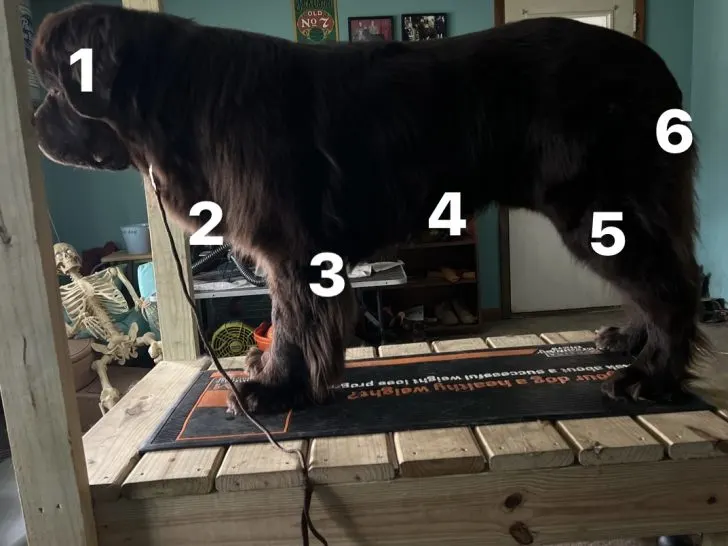
This is why it’s important to regularly line comb your dog’s hair in sections using a stainless steel comb.
Another mistake you could be making is only brushing the top of your dog.
I’m guilty of this because my dog’s back is the easiest area to reach so it gets brushed a lot.
Mats rarely form on the back of a dog so instead of focusing on the easy area, I’ve trained myself to go for the areas that tend to mat the most first.
My Dog Doesn’t Look Matted
Most well-cared-for dogs aren’t going to look matted to the naked eye.
The mats are hiding in less obvious areas and under the topcoat.
You can easily run a brush through a dog’s coat even if it’s matted but you can’t easily run a comb through it.
This is why a lot of professional dog groomers will do a comb test on a dog before they start grooming.
If they can’t run a comb through a dog without it getting stuck, most likely they’re going to clip that area.
High-Priority Areas You Shouldn’t Ignore
Matted fur happens mostly due to friction but seasonal shedding, allergies, parasites and water can also be a cause.
It’s important to pay close attention to those areas and comb them regularly.
These high-priority areas are:
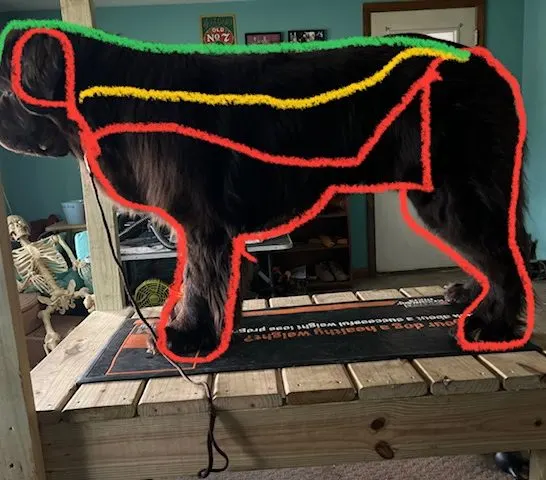
Red=high priority
Yellow=medium priority
green-low priority
- Under the ears
- Neck
- Chest
- In between the front legs
- Armpits
- Belly
- Back legs (pants, rump, groin)
Ears
The hair behind a dog’s ears is definitely a very common area where mats tend to form.
My Newfie’s have had their fair share of small ear mats and I usually don’t notice them until I’m giving them an ear massage.
Mats under the ear can form for a variety of reasons such as wearing a collar, ear infection, shaking their head, itching their ears with their paws, rubbing their ears on the ground and in the water bowl….etc.
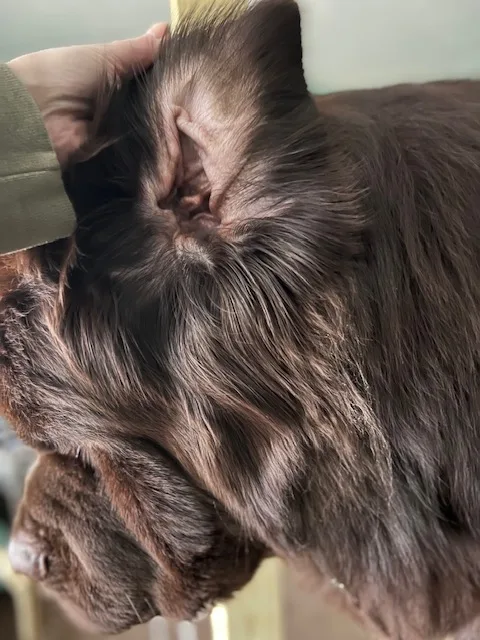
We hope that you like the products we featured in today’s post. Just so we’re clear, My Brown Newfies is a participant in the Amazon LLC Associates Program, an affiliate advertising program designed to provide a means for sites to earn advertising fees by advertising and linking to Amazon.com and other affiliate programs:)
Solution
Combing the hair behind/under your dog’s ears is an effective way to manage small mats.
I personally like to use a fine-toothed comb under the ears but a regular combination comb works well too.
If you find an ear mat, if it’s small you can either try to comb it out with some detangling spray and a dog comb or a slicker brush.
You can also try using a little bit of cornstarch to break the mat up or use a mat splitter.
Small dog clippers are another option but if there’s a big mat, consider taking your dog to a professional groomer.
Neck
Mats on a dog’s neck can sometimes be hard to spot.
They can form due to the friction of a dog collar or if you have a dog that slobbers a lot like Newfies, it can be because they’re always wet.
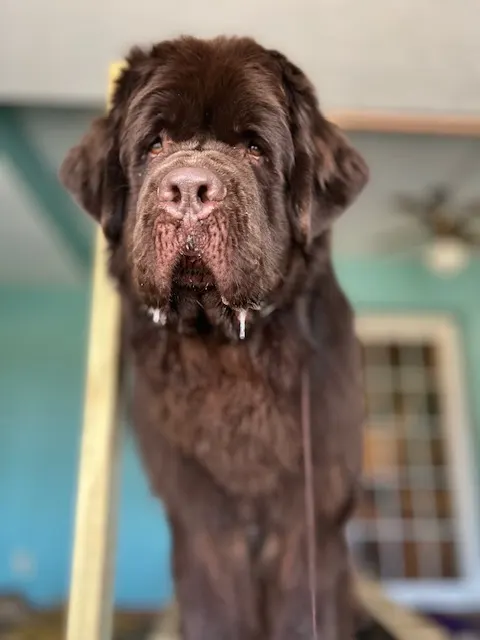
Solution
Make sure to brush and line-comb all the way around the neck frequently and if your dog is a heavy drooler, consider a drool bib or bandana.
Chest
The chest area is similar to the neck but further down to the bottom of the chest right between the front legs is another high-maintenance area that tends to mat easily on Newfoundlands.
This is a very common spot where Odin gets small mats and it’s normally due to where his walking harness sits.
It’s also a high-friction area because the front legs are always moving.
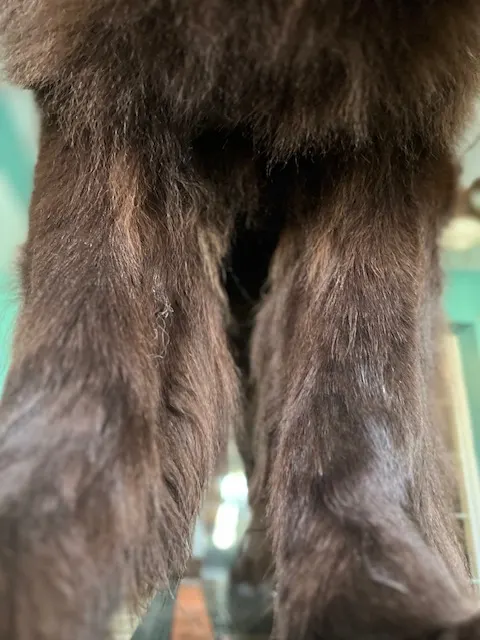
Solution
Weekly brushing of this area with a slicker brush, rake or coarse comb.
Make sure to use a detangling spray.
These mats are usually more like small tangles and can easily be trimmed out, combed out or sprinkle a little cornstarch on them.
Armpits
The armpits are a VERY common place for mats to form due to friction.
I find that the type of hair a dog has plays a role too.
Odin has a coarser coat than Lou and tends to get small mats in this area more.
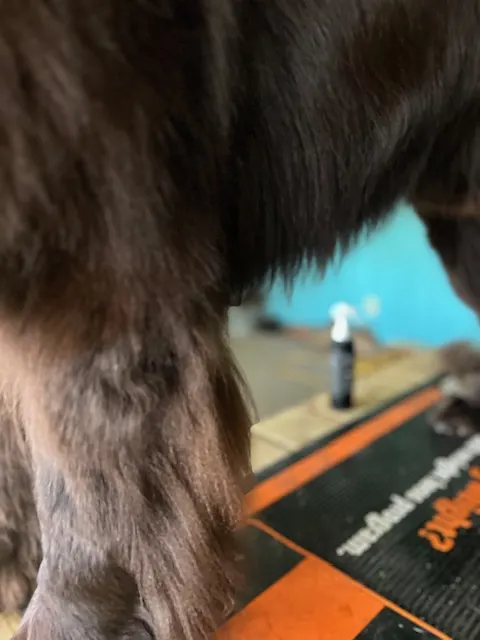
Solution
Weekly combing with a coarse comb or combination comb.
A lot of people like to use a slicker brush in this area but personally, I don’t.
It’s a tender area and the coat is thin there so I prefer to use a comb but you can use whatever you’re comfortable with.
Belly
The adorable Newfie belly.
The hair is usually shorter here but still thick and since it’s constantly being pressed down when the dog sleeps, it’s a high-maintenance area that tends to mat.
This area is usually more matted than tangled.
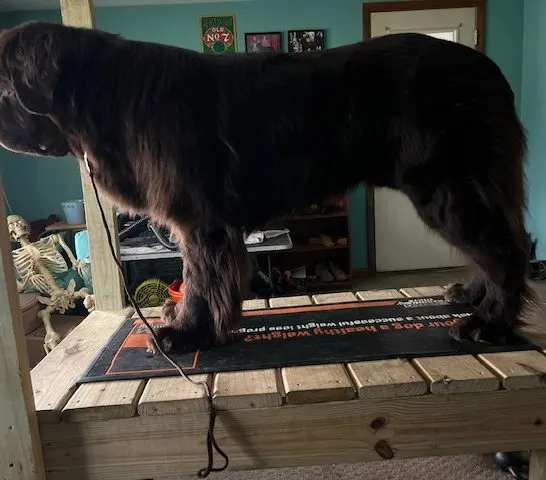
Solution
I like to use a pin brush followed by a comb.
Back Legs
I’m grouping the back legs and rump area (including the groin) into one here.
This area is IMO, the hardest area to maintain.
More so the pants or hair from the base of the tail to the hocks.
This is usually very coarse hair that some people refer to as yak butt.
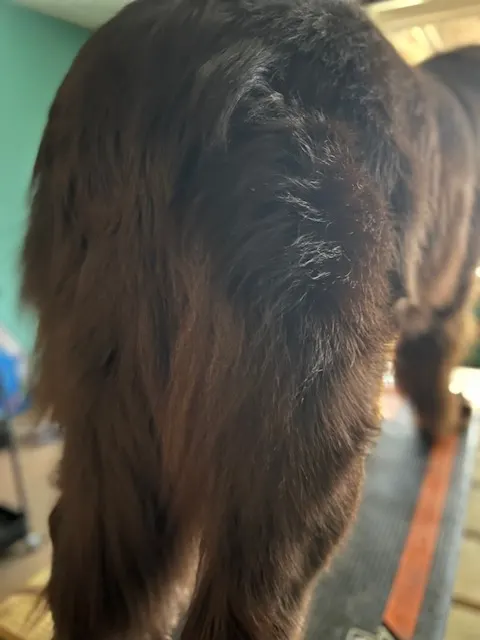
In a perfect world, this entire area should be brushed and combed daily.
If left unattended it can mat quickly and the mats just grow and grow.
If heavy matting is found in this area, I would contact a professional dog groomer instead of trying to comb through them because that can be painful and tedious.
Solution
Brush and comb regularly and don’t forget the groin area.
Use a grooming spray or a diluted dog conditioner in a spray bottle.
I try to line comb this area at least once a week.
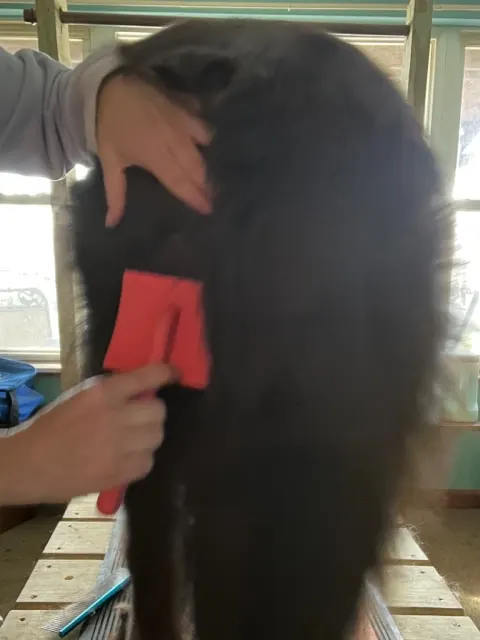
I use a pin brush then a slicker brush and then a coarse comb.
If your dog is licking their groin a lot, check for mats and tangles regularly.
Best Grooming Tools For Double Coats
The grooming tools that you use to brush or comb your Newfie will depend on their coat texture and coat health.
Wait, Newfies don’t all have the same texture coat?
Nope!
All Newfies are going to have a double coat but the texture of their coat can vary.
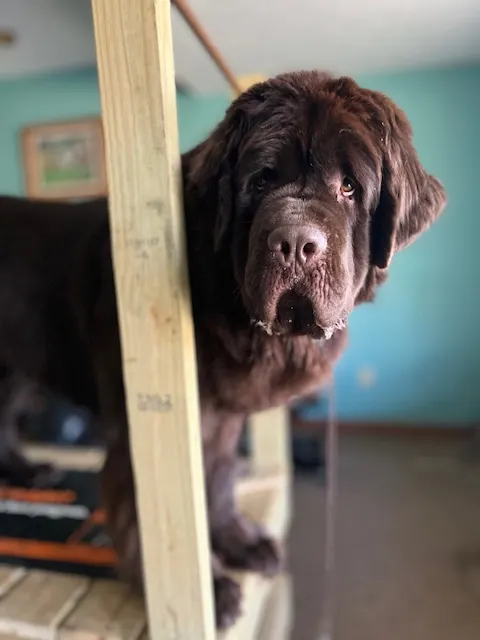
For instance, Lou doesn’t have his full adult coat yet but right now his coat is soft and silky.
Odin’s coat is more coarse, especially the white hair.
He also has much thicker hair on his back end.
Dogs that have been spayed or neutered can also have a different texture to their coat than intact dogs.
So the grooming tools I use on my dogs might be different than the grooming tools that work well with your dog’s coat.
With that being said, the most common tools that are used in high-maintenance areas are:
It’s usually recommended to brush your dog with a pin brush or slicker brush and then a comb.
If your dog is blowing coat some people will use a grooming rake and or/Sullivan comb.
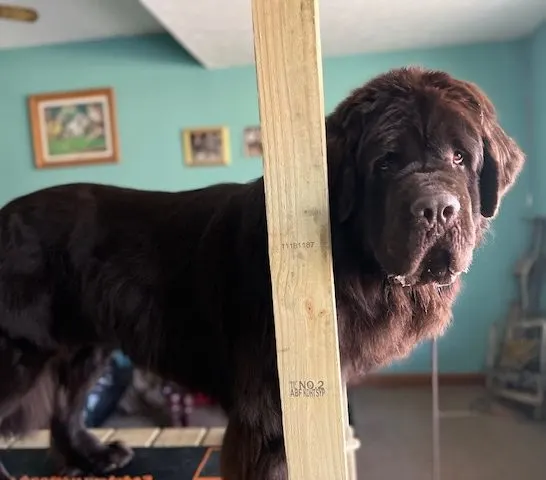
What Grooming Spray To Use For Your Newfie
Grooming spray or detangling spray falls into the same process as grooming tools, it ultimately depends on your dog’s coat.
I use different sprays for Odin and Lou.
Personally, I lump grooming sprays and detangling sprays into the same category but different sprays do different things.
They’re all conditioning sprays and add moisture to a dog’s coat but they have different ingredients.
Some contain silicone, parabens, alcohol, and fragrance and of course, cost plays a role.
Grooming sprays not only help with mats and tangles but also cut down on static electricity and make your dog’s coat more manageable and healthy.
Some grooming sprays even contain sunscreen, and some repel dirt and urine!
If you use a topical flea and tick medication on your dog, you do have to be careful that the detangling spray doesn’t interact with that.
p.s. Don’t forget to check your dog’s paws for mats. The constant moisture in between the paw pads is not only a perfect breeding ground for bacteria but also a common place where mats form on Newfoundlands.
I only endorse and recommend products that I personally use or products that come highly recommended by my peers. Please don’t spend money on any of these products unless you believe they are best for you and your Newfoundland. Read our full privacy policy here.